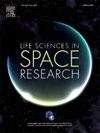国际空间站上的 3D 生物打印半月板组织。
IF 2.8
3区 生物学
Q2 ASTRONOMY & ASTROPHYSICS
引用次数: 0
摘要
我们利用舱载生物制造设施(BFF)在国际空间站(ISS)上对半月板组织进行了生物打印。三维(3D)打印生物墨水、细胞、培养基和固定液由 NG-18 号和 SpX-27 号运载火箭运送到国际空间站,并在打印操作前储存起来。半月板组织由 I 型和 II 型胶原、硫酸软骨素和间充质干细胞组成的墨水制成。打印完成后,半月板组织在生长培养基中培养 2 周,然后储存在 4 °C,再送回地球进行分析。打印的半月板组织显示出良好的整体形状保真度,尺寸与在地球上打印的对照半月板组织相当。国际空间站打印半月板的杨氏模量比对照组低约 4 倍。组织学评估显示,印模内的细胞分布良好。虽然在向国际空间站运送有效载荷的过程中遇到了后勤方面的挑战,而且操作方面的挑战也限制了这项研究的细胞培养部分,但这项调查证明了在微重力环境下三维打印肌肉骨骼组织的可行性。打印完成的半月板组织是迄今为止在国际空间站上三维打印的最大组织工程模型,也是首个使用与本地组织成分相似的墨水进行三维生物打印的模型,还是首个在国际空间站上制作的解剖相关形状的模型。这些实验有助于推进低重力或微重力环境下的组织工程领域,三维生物打印技术可能会在未来的长期太空飞行或地外居住中发挥作用。本文章由计算机程序翻译,如有差异,请以英文原文为准。
3D bioprinting meniscus tissue onboard the International Space Station
We bioprinted meniscus tissue on the International Space Station (ISS) using the onboard BioFabrication Facility (BFF). The three dimensional (3D) printing bioink, cells, culture media and fixative were delivered to the ISS on NG-18 and SpX-27 vehicles and stored prior to the printing operation. The meniscus tissue was fabricated from ink composed of collagens type I and II, chondroitin sulfate and mesenchymal stem cells. Following printing, the meniscus tissue was cultured for 2 weeks in growth media, then stored at 4 °C and returned to earth for analysis. The print showed good overall shape fidelity, and dimensions were comparable to control meniscus tissue printed on Earth. Young's modulus of the ISS printed meniscus was approximately 4-fold lower than the control. Histologic evaluation showed good cell distribution within the print. Though logistical challenges were encountered during payload delivery to the ISS and operational challenges limited the cell culture portion of this study, this investigation demonstrated the feasibility for 3D printed musculoskeletal tissue in microgravity. The completed meniscus tissue print is the largest tissue engineered model 3D printed on the ISS to date, the first to be 3D bioprinted using an ink similar in composition to native tissue, and the first to be fabricated on the ISS in an anatomically relevant shape. These experiments help advance the field of tissue engineering in low or microgravity where 3D bioprinting may have a role in future long term space flight or extraterrestrial habitation.
求助全文
通过发布文献求助,成功后即可免费获取论文全文。
去求助
来源期刊

Life Sciences in Space Research
Agricultural and Biological Sciences-Agricultural and Biological Sciences (miscellaneous)
CiteScore
5.30
自引率
8.00%
发文量
69
期刊介绍:
Life Sciences in Space Research publishes high quality original research and review articles in areas previously covered by the Life Sciences section of COSPAR''s other society journal Advances in Space Research.
Life Sciences in Space Research features an editorial team of top scientists in the space radiation field and guarantees a fast turnaround time from submission to editorial decision.
 求助内容:
求助内容: 应助结果提醒方式:
应助结果提醒方式:


